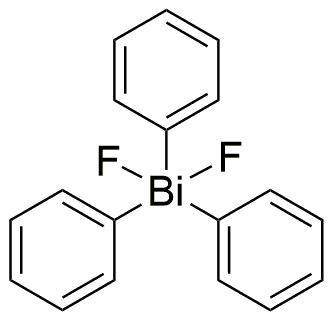Triphenylbismuth difluoride is widely utilized in research focused on:
- Catalysis: This compound serves as a catalyst in various organic reactions, enhancing reaction rates and selectivity, particularly in the synthesis of complex organic molecules.
- Material Science: It's used in the development of advanced materials, including semiconductors and polymers, due to its unique electronic properties, which can improve material performance.
- Pharmaceuticals: In medicinal chemistry, it plays a role in the synthesis of bismuth-containing compounds that exhibit antimicrobial properties, offering potential alternatives to traditional antibiotics.
- Analytical Chemistry: It is employed in analytical applications, such as spectroscopy, where it helps in the detection and quantification of trace elements in various samples.
- Environmental Chemistry: This compound is investigated for its ability to act as a reagent in environmental remediation processes, aiding in the removal of heavy metals from contaminated sites.
General Information
Properties
Safety and Regulations
Applications
Triphenylbismuth difluoride is widely utilized in research focused on:
- Catalysis: This compound serves as a catalyst in various organic reactions, enhancing reaction rates and selectivity, particularly in the synthesis of complex organic molecules.
- Material Science: It's used in the development of advanced materials, including semiconductors and polymers, due to its unique electronic properties, which can improve material performance.
- Pharmaceuticals: In medicinal chemistry, it plays a role in the synthesis of bismuth-containing compounds that exhibit antimicrobial properties, offering potential alternatives to traditional antibiotics.
- Analytical Chemistry: It is employed in analytical applications, such as spectroscopy, where it helps in the detection and quantification of trace elements in various samples.
- Environmental Chemistry: This compound is investigated for its ability to act as a reagent in environmental remediation processes, aiding in the removal of heavy metals from contaminated sites.
Documents
Safety Data Sheets (SDS)
The SDS provides comprehensive safety information on handling, storage, and disposal of the product.
Product Specification (PS)
The PS provides a comprehensive breakdown of the product’s properties, including chemical composition, physical state, purity, and storage requirements. It also details acceptable quality ranges and the product's intended applications.
Certificates of Analysis (COA)
Search for Certificates of Analysis (COA) by entering the products Lot Number. Lot and Batch Numbers can be found on a product’s label following the words ‘Lot’ or ‘Batch’.
*Catalog Number
*Lot Number
Certificates Of Origin (COO)
This COO confirms the country where the product was manufactured, and also details the materials and components used in it and whether it is derived from natural, synthetic, or other specific sources. This certificate may be required for customs, trade, and regulatory compliance.
*Catalog Number
*Lot Number
Safety Data Sheets (SDS)
The SDS provides comprehensive safety information on handling, storage, and disposal of the product.
DownloadProduct Specification (PS)
The PS provides a comprehensive breakdown of the product’s properties, including chemical composition, physical state, purity, and storage requirements. It also details acceptable quality ranges and the product's intended applications.
DownloadCertificates of Analysis (COA)
Search for Certificates of Analysis (COA) by entering the products Lot Number. Lot and Batch Numbers can be found on a product’s label following the words ‘Lot’ or ‘Batch’.
*Catalog Number
*Lot Number
Certificates Of Origin (COO)
This COO confirms the country where the product was manufactured, and also details the materials and components used in it and whether it is derived from natural, synthetic, or other specific sources. This certificate may be required for customs, trade, and regulatory compliance.


